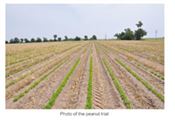|
Field Performance Of Twelve Peanut Cultivars In Mississippi County, Arkansas

DR. TRAVIS FASKE AND DR. ANDY VANGUILDER
LONOKE, ARK.
To assess field performance of multiple peanut cultivars in one of the major peanut growing counties in Arkansas, Mississippi County, an on-farm field trial was established. The cultivars were planted on May 15 at a seeding rate of 6 seed/ft of row. Plots consisted of two, 30-ft-long rows spaced 38-in apart separated by a 10-ft fallow alley. Seed was provided by Foundation seed in Alabama, Georgia, Florida, and Oklahoma. The cultivar Contender is a Virginia-type peanut and the very large seed did not work well with normal peanut plates. Thus, all ‘Contender’ plots had less than 100 percent stand, maybe 50 percent on average. The experimental design was a RCBD with four replications per cultivar. Field plots were furrow irrigated and managed as per grower’s normal production practice, which included three fungicide applications. Late leaf spot was assessed in October using the Florida scale. Digger loss was estimated after digging based on number of peanuts in a 1 sq ft transects systemically placed at beginning and middle of plots. Weights for 100 pods for each cultivar was used to estimate digger loss. Peanut plots were dug on Oct 18 (156 DAP) and thrashed with a mobile plot thrasher on Nov 5. A green weight was taken for replications 1, 2, and 3, while a dry weight was determined for block 4. The difference in green weight and dry weight were used to determine yield in block 1, 2, and 3. A 2-lb sub sample was graded at Birdsong Buying Point in Portia, AR. Data was subject to AOV using ARM.
The field was previously grown for two years in cotton and the initial southern root-knot nematode population density at planting was 120 J2/100 cm3 of soil, which is a moderate threshold for cotton in Arkansas. The southern root-knot nematode population density at harvest was zero with a slight increase in lesion and spiral from the initial counts, but not at an action threshold for peanut or cotton. This data supports the rotation of peanut with cotton in Arkansas.
Late leaf spot was observed in October, but too late to have a significant impact on yield. The cultivar with the greatest severity of late leaf spot was the Auburn cultivar AU-NPL 17. During the season it was noted that the Oklahoma cultivar Lariat had excessive vine growth. Pod yields were good with an average of 6,346 lb/A across cultivars. The runner-type peanut cultivars with the greatest (P = 0.05) yield average consisted of TufRunner 297, Georgia 12Y, and Lariat compared to the Algrano IPG 914, Algrano IPG QR-14 and AU-NPL 17 cultivars. This yield data does not include estimated digger loss, which likely lowered yield for Algrano IPG QR-14, Georgia 16HO, and Lariat, which had the greatest digger loss. Yields are reported at 6 percent moisture. The runner-type peanut cultivars with the best grade was Georgia 16HO and Georgia 18RU and the greatest value per ton. There was a high percentage of sound splits with Georgia 09B, Lariat, Georgia 18RU, which may have been due to very low percent moisture (6 percent) at the of grading. Those cultivars with the greatest value per acre was TUFRunner 297 and Lariat.
The authors would like to thank the Arkansas peanut producer, Arkansas peanut board, and National peanut board for supporting this field research plot. We would like to thank David Wildy for allowing us to have or plots on his farm and Dale Wells for communicating the logistics of planting and harvest. Further, authors would like to recognize and thank Delta Peanut and Birdsong peanut for seed in other trials and grading, respectively . ∆
DR. TRAVIS FASKE: Extension Plant Pathologist and DR. ANDY VANGUILDER: Instructor – ANR Educator, University of Arkansas
|
|